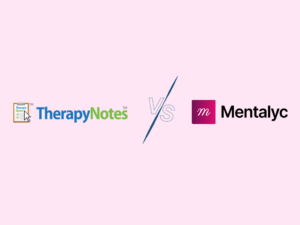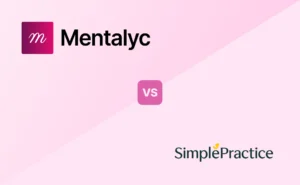Working through your struggles with the support of people facing similar issues can be a real game-changer. The whole give-and-take of help can really bring out the best in us. After all, humans have been tackling life’s challenges together in squads since the dawn of walking on two legs.
Penning progress notes in group therapy, however, is a bit tricky, especially when you’re new to the whole group scene. So, let’s break down how these group therapy notes go down and dissect what makes them tick. Then, we’ll hit you with some wicked tips to level up your group therapy note game, starting right now.
Wait, What Are We Talking About?
Group therapy, a form of psychotherapy, involves one or more therapists collaborating with multiple individuals simultaneously.
This method of treatment is easily available in different settings, such as individual therapy practices, medical facilities, mental health clinics, and local community centers.

New! Transfer your notes to EHR with a single click. No more copy-pasting.
While group therapy can function as a standalone treatment, it is commonly integrated into a comprehensive treatment plan, often complementing individual therapy.
Group sizes can vary, with sessions typically comprising eight to 12 participants, although larger groups are possible. Meetings are generally held weekly or biweekly for one to two hours.
The Group therapy sessions can be closed or open. Open sessions welcome new participants at any time, while closed sessions are limited to a core group of established members.
Different Types of Group Therapy
Group therapy can be categorized based on the targeted mental health condition and the clinical techniques employed during sessions. Forms of group therapy include:
Cognitive Behavioral Groups:
These focus on recognizing and modifying inaccurate or distorted thought patterns, emotional responses, and behaviors.
Psychoeducational Groups:
These aim to educate participants about their disorders and coping strategies, often drawing from cognitive-behavioral therapy (CBT) principles.
Interpersonal Groups:
These emphasize interpersonal relationships, social interactions, and the role of support from others in shaping mental health.
Skills Development Groups:
These concentrate on enhancing social skills for individuals with mental disorders or developmental disabilities.
Support Groups:
These offer various benefits to individuals with a wide range of mental health conditions and their loved ones.
What does a typical group therapy session look like?
In many cases, a group therapy session unfolds in a room where chairs are thoughtfully arranged in a large circle, fostering an atmosphere of openness and inclusivity. This seating arrangement allows every member to maintain eye contact with one another, reinforcing a sense of connection and support.
The session commences with group members introducing themselves and offering personal insights into their reasons for seeking group therapy. The space is then filled with shared experiences and progress updates since the last meeting, cultivating an environment of mutual understanding and growth.
The precise manner in which the session unfolds and any therapeutic activities employed depend on the group’s objectives and the therapist’s unique style. Some therapists promote a more free-form approach, where each member engages as they feel comfortable, fostering organic discussions and insights. Conversely, other therapists may follow a structured plan for each session, which can include practical exercises aimed at building new skills and fostering collaboration within the group.
Why “Group” Therapy?
Group therapy is a powerful and versatile healing modality that offers a safe haven for individuals facing a myriad of challenges. Whether grappling with conditions such as ADHD, depression, or eating disorders, or contending with the weight of generalized anxiety, panic disorder, phobias, or the haunting specter of PTSD, group therapy provides a beacon of hope and support. It also extends its compassionate hand to those battling substance use disorders, fostering a sense of community and shared strength in their journey toward recovery.
Beyond mental health concerns, group therapy, particularly when rooted in Cognitive-Behavioral Therapy (CBT), proves itself as a transformative force in helping individuals manage their emotions. Whether learning to navigate the turbulent waters of anger, easing the burden of chronic pain and illness, or navigating the complexities of divorce and domestic violence, group therapy serves as an invaluable ally.
Wait, How Do I write a Group Therapy Note?
Hey, first things first, group progress notes ain’t all that different from going solo with individual progress notes. Take a deep breath and chill because you got this.
The notes are pretty much a mirror image, and some parts are like, totally identical, which will help you save time.
The major difference between the two is that you need to document both the one-on-one and the group vibes. And the good news? It’s a breeze.
So, let’s dive into the art of writing group therapy notes.
STEP ONE
Stick to your regular progress notes format, whether it’s DAP, SOAP, GIRP, PIRP, or your very own style.
Cover all the basics, like how the individual client rolled, group dynamics, group-to-client interactions, client-to-group interactions, their influence on the group, and how the group worked their magic on them.
Sounds like a lot, but I swear, it’s no biggie, and I’ll further elaborate in a separate section.
STEP TWO
Here’s my golden nugget for fellow therapists writing group notes: DON’T BE A BROKEN RECORD!
In other words, don’t double up your efforts. You can kinda “hack” your way through group progress notes and save yourself some time. How, you ask? Well, as you work your magic with the group, drop a therapeutic gem that applies to all of them. No need to write it out five or ten times. Scribble it once, then copy-paste it into everyone’s individual counseling note.
I can practically hear your sigh of relief, even through the screen.
Now, don’t get me wrong, you still need to jot down individual case notes for each member, ’cause they’re all UNIQUE clients deserving their own therapy records. So, you’ll have a section in the progress note for the entire group session (the interventions that apply to all) and a few lines specific to each individual client. Piece of cake, right?
And now? You’re good to go!
Tips to Write Better Group Therapy Notes (Elements of a Group Therapy Note)
When it comes to crafting a kickass group note for each member of your crew, don’t sweat it – you can make this process a whole lot smoother. Here’s what you’ll need to include:
Group Summary:
This section lays down the basics: group name, main topics tackled in the session, the interventions you pulled off, and the schedule. Since this part’s identical for everyone, go ahead and copy-paste it into each client’s customized note.
Client’s Group Vibes:
In the personal bits, make sure you document how the client rocked it in the group. Highlight details like their level of engagement, what they brought to the table, and how they reacted. Are they engaged in the group, or are they more of a chill observer in the mix?
Group’s Reaction to the Client:
Let’s draw on how the group responded to the client. Were they all welcoming and chill, or did the group struggle to vibe with the client during the conversation?
Client’s Impact on the Group:
Each group has its own flavor, and every member spices it up differently. Break down how the client influenced the group. Did they steer the conversation in a new direction, turning up the heat in the discussions?
Group’s Impact on the Client:
Group dynamics is a two-way street. In this part, jot down how the group left its mark on the client. Did the group’s thoughts on a particular topic hit home and shake up the client’s perspective? Were they amped up for change thanks to the group’s support?
What is a Group Progress Note?
A group therapy progress note is a comprehensive and structured documentation of the developments, interactions, and achievements within a group therapy session. It is a vital tool for mental health professionals to track the progress of individuals in a group setting, evaluate the effectiveness of therapeutic interventions, and plan for future sessions. The content of a group therapy progress note follows the above guidelines and is organized in a systematic and concise manner, providing a snapshot of the session’s dynamics and the group’s overall therapeutic journey.
When summarizing the group’s progress over time, focus on key themes, milestones, and observed changes. Assess whether the group is moving toward its therapeutic goals and if there are emerging patterns or shifts in the group dynamics. This perspective provides valuable insights into the overall effectiveness of the group therapy process.
When documenting a participant’s behavior, be specific, objective, and relevant. Include positive contributions, challenges faced, and interactions with other group members. For example, note if a participant actively participated in a discussion, shared a personal struggle, or offered support to a peer. Avoid unnecessary personal details and focus on behaviors that directly impact the therapeutic process.
By paying attention to these elements in group therapy notes, you can create a comprehensive and valuable record of each session, facilitating effective ongoing therapy for the group.
Group Therapy Note Example and Template
An example of a group therapy session note could be a support group for individuals dealing with anxiety. The session might focus on sharing coping strategies, discussing personal experiences, and providing mutual support. Review the following example:
Example Scenario: Support Group for Coping with Generalized Anxiety Disorder
In this session, the focus is fostering a safe space for group members to share coping strategies, exchange personal experiences, and mutually bolster one another. The group, led by a skilled psychotherapist (Dr. Thompson), aims to tap into the collective wisdom of its members to confront and navigate the challenges posed by generalized anxiety disorder (GAD).
Comprehensive Elements of Group Therapy Note.
Header Information Date: November 10, 2023
Time: 6:00-7:30 pm
Location: Virtual support group, Zoom
Names of Participants: Marta, Ann, Bob, Chris, Amy, and George
Absent: Miguel, Robert
Objective and Theme The objective of this session is to create a safe space for participants to share effective coping strategies and exchange personal experiences, fostering mutual support within the context of the group. The theme revolves around skill-building, emotional exploration, and reinforcing a sense of community among members dealing with Generalized Anxiety Disorder (GAD).
Group Dynamics The virtual setting facilitated an open and respectful environment for group members to engage in the discussion. Verbal and non-verbal interactions were observed, indicating a sense of camaraderie and trust within the group. Moments of shared understanding and empathy contributed to a positive emotional atmosphere.
Individual Contributions Marta: Shared a personal coping strategy involving mindfulness techniques, contributing to the group’s understanding of helpful approaches.
Ann: Discussed a recent challenge related to a panic attack, prompting a supportive response from the group, highlighting the effectiveness of mutual encouragement.
Bob: Demonstrated vulnerability by sharing a specific anxiety trigger, fostering a deeper level of trust among group members.
Chris: Offered specific time management tips, emphasizing the importance of routine in managing anxiety.
Amy: Raised a question about cognitive-behavioral techniques, prompting a group discussion on practical applications and personal experiences.
George: Shared a personal triumph in applying a coping skill discussed in a previous session, providing inspiration for others.
Interventions
- Psychoeducation: Dr. Thompson provided additional information on cognitive-behavioral techniques and encouraged participants to explore personalized applications.
- Reflective Questioning: Utilized to deepen discussions, allowing members to explore the emotional foundations of their experiences.
- Positive Reinforcement: Acknowledged and reinforced positive contributions, fostering a supportive atmosphere within the group.
Homework or Assignments Group members were assigned the task of journaling their experiences with implementing at least one coping strategy discussed during the session. The relevance of this assignment was emphasized in connection with individualized skill-building and personal growth.
Group Progress The session revealed a notable progression in the group’s cohesion and willingness to share personal experiences. Members exhibited increased comfort with vulnerability, contributing to the establishment of a more resilient and supportive group dynamic.
Plans for the Next Session The next session will include a deeper exploration of specific cognitive-behavioral techniques, allowing members to share their experiences with implementation. Additionally, there will be a focus on discussing challenges encountered in applying coping strategies and collaborative problem-solving within the group.
Confidentiality All shared information was treated with the utmost confidentiality, and members were reminded of the importance of respecting each other’s privacy outside of the group setting.
Mentalyc Insights: Strategies for Improving the Quality of Group Notes
Crafting effective therapy notes not only reduces the risk of insurance denials but also enhances your ability to closely monitor each client’s progress, thereby making your therapeutic interventions more impactful.
Whether you are a seasoned provider of group therapy notes or relatively new to this practice, here are four time-tested strategies to help you create more concise and informative group therapy documentation.
Maintain Objectivity:
Remaining impartial can be challenging, especially when dealing with clients who have strong personalities or challenging behaviors. However, it is crucial to view each client through an objective lens when describing their interactions within the group. Avoid any language that may come across as judgmental, and focus solely on what is objectively observable. Steer clear of recording personal opinions or emotions that are not rooted in facts. Be mindful of your own biases and take extra care to maintain objectivity in your client summaries.
Protect Client Confidentiality:
Ensure that your individualized group therapy notes contain only identifiable information about the client you are documenting. When describing group dynamics and the client’s interactions with others, refrain from including any identifying details about other group members. If you need to document an interaction between the client and another group member, do not use names, not even their first names. Alternatively, use generic terms to describe the other people in order to safeguard their anonymity.
Prioritize Clarity and Precision:
The best practice for every progress note is to write it in a way that another therapist can seamlessly continue the therapy process. Progress notes serve multiple purposes, including documenting current progress and planning future interventions, as well as maintaining a historical record of the client’s therapy journey over time. When composing group notes, be thorough and explicit. Remember that even though you have crucial insights and background information on the client, it is essential to document it on paper. Well-structured progress notes not only enhance the quality of care but also reduce the likelihood of claim denials or delays due to insurers’ requests for additional information.
Describe Session Methods and Interventions:
Group sessions typically revolve around a specific theme or topic. For example, a session for clients dealing with substance abuse disorder may center on identifying triggers that lead to relapse. After discussing these triggers, a general plan for relapse prevention is presented, with each group member crafting a personalized plan.
In general, it is important to clearly define your responsibilities as the leader of the group and to detail any therapeutic interventions you used during each personalized group therapy session in the therapy notes.
And that’s it! Always remember, if you face any challenges, Mentalyc is here to support you.
Conclusion
Crafting effective group therapy notes requires a balance between capturing the nuances of group dynamics and maintaining the confidentiality and professionalism inherent in therapeutic practice. Group notes serve not only as a record of the session but also as a roadmap for the ongoing therapeutic process of the group. By documenting individual contributions, interventions, and the overall group progress, you can gain valuable insights into the collective and individual experiences of group participants. Thoughtful, clear, and comprehensive notes aid in continuity between sessions and contribute to the therapeutic process by providing a reflective tool for you and group members alike.
References:
- Grunebaum H, Kates W. Whom to refer for group psychotherapy. Am J Psychiatry. 1977 Feb;134(2):130-3.
- Ezhumalai, S., Muralidhar, D., Dhanasekarapandian, R., & Nikketha, B. S. (2018). Group interventions. Indian Journal of Psychiatry, 60(Suppl 4), S514-S521.
Why other mental health professionals love Mentalyc

“By the end of the day, usually by the end of the session, I have my documentation done. I have a thorough, comprehensive note … It’s just saving me hours every week.”
CDCII

“It takes me less than 5 minutes to complete notes … it’s a huge time saver, a huge stress reliever.”
Licensed Marriage and Family Therapist

“It’s so quick and easy to do notes now … I used to stay late two hours to finish my notes. Now it’s a breeze.”
Licensed Professional Counselor

“A lot of my clients love the functionality where I can send them a summary of what we addressed during the session, and they find it very helpful and enlightening.”
Therapist






